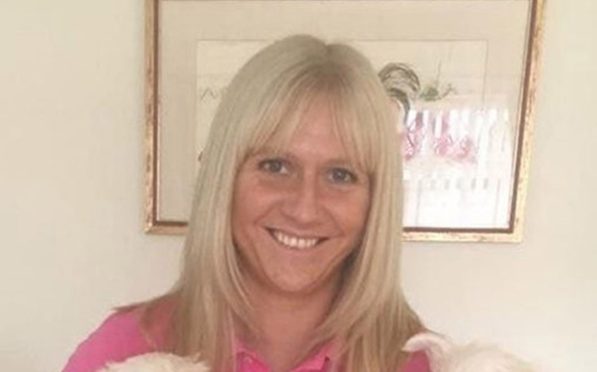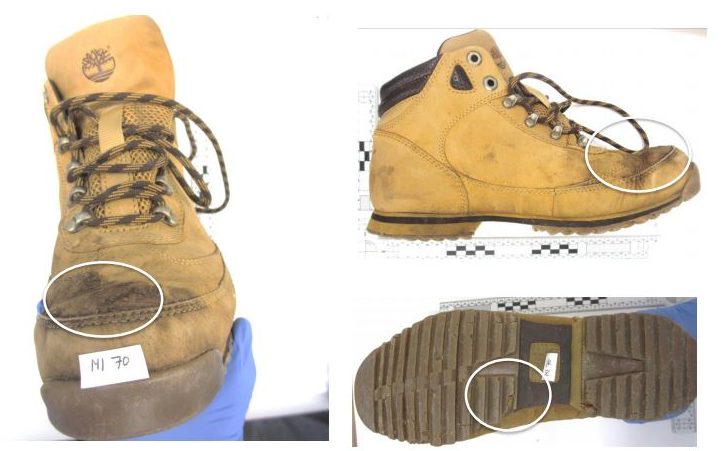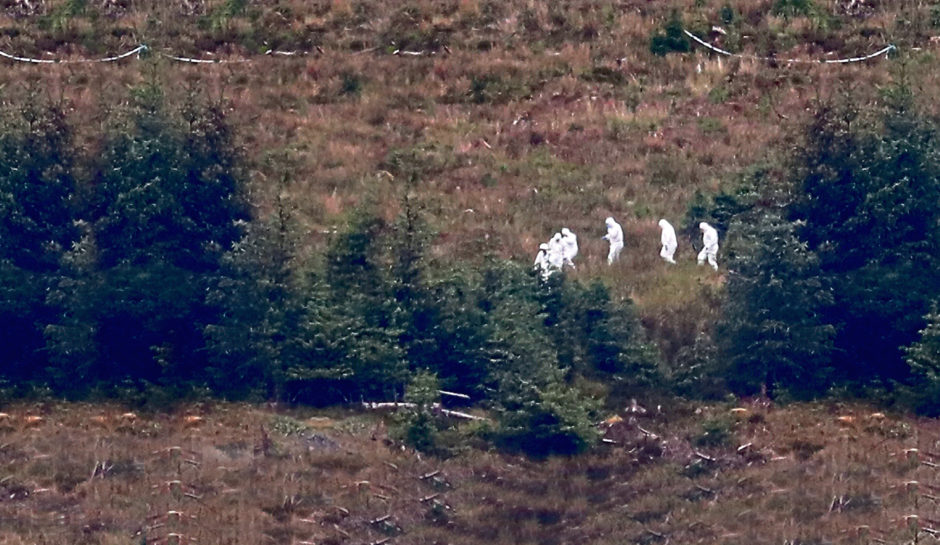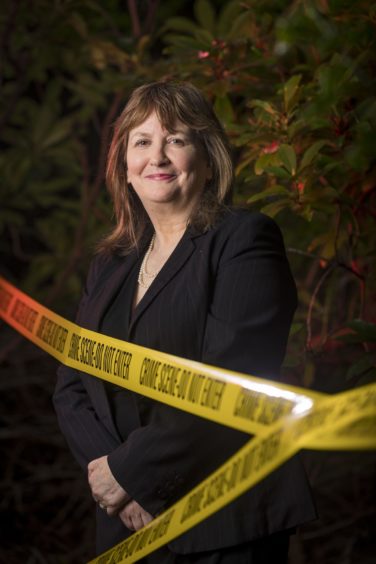
They were old and battered, the sole cracked, the laces filthy… but the Timberland hiking boots were to catch a killer.
Today, the forensic scientist who led the team that identified miniscule traces of plants and soil trapped in the soles of the £80 boots reveals how those footprints would lead from a remote forest where the calculating killer had left his victim’s body all the way to his door.
Former prison officer Ross Willox, 42, was last week convicted of the murder of his friend Emma Faulds, of Kilmarnock, after taking elaborate measures to conceal his tracks.
Professor Lorna Dawson, who heads up the team of forensic experts at the James Hutton Institute in Aberdeen explained how microscopic traces of soil recovered from Willox’s boots were seized by police.
The Aberdeen team’s work was pivotal in helping search teams find the body of youth worker Emma, 39, in Glentrool Forest, Dumfries and Galloway, in April 2019, six weeks after her death, and then link her killer to the scene.
Prior to the forensics breakthrough police had been scouring a different part of the 500-square-mile forest landscape. They knew Willox, the last person to have seen Emma alive and the prime suspect, had previously worked on wind farms in the area. And, 24 hours after the Aberdeen team delivered its analysis, the search team found Emma’s body.
The samples from his boot linked Willox to the crime scene and were instrumental in his conviction on Tuesday after a six-week trial.
Dawson explained: “One of the police officers in the search team was a mountain biker and knew the topography (the physical features of the landscape) well and suggested areas to prioritise from the description of the soil and vegetation that we found on Ross Willox’s boots.
“It was clearly a peat on an upland boggy area. The composition of the mosses on the accused’s boots was consistent with those seen at the area where Emma was found. Seven of the 12 plant species observed to be at the area where Emma was found were recovered from Willox’s boots. Our botanist at the institute identified the species of moss found on the boots using high-power microscopy.”
Emma had been reported missing by her parents when she failed to turn up for work two days after going to Willox’s home in Monkton, Ayrshire. He did nothing to help the search and, it emerged, had already driven her body to the forest.
As police teams methodically searched the area, Dawson’s team were using science to narrow the hunt.
She said: “We used gas chromatography (the process whereby the various elements of a compound are separated into their distinct parts for individual analysis) in the evidential phase of the operation and showed the peat on the soles of the Timberland boots also had the same organic profile as was found at the scene.
“Our botanist identified the individual recovered mosses. From this we knew that the person who wore the boots had likely stood in the area where Emma was found. There was also an organic peat stain on the boots which showed they had been partially submerged in peaty water.
“Puddles containing peaty water were located in the hollows between the clumps of moss and rushes at the scene. Trees had been planted around 2016 in that general area and may not have been felled for another 40 to 60 years, which might have left Emma hidden in the undergrowth.
“She was covered with clumps of mosses and the rushes which had been pulled from the ground a few metres away from her body in an attempt to conceal her.
“Soil can be distinctive in a range of chemical, physical and biological characteristics, including the soil organic profile, soil elemental composition and soil mineralogy. Depending on the type of soil, different methods are used in forensic case work. In this case, because of the organic nature of the soil, organic plant wax marker analysis was used. In addition, the distinctive plant community added another link to the scene.”
Without the police and forensic experts’ efforts Emma’s body may never have been found and her family would not have known if she was alive or dead. Dawson added: “What the police search did was to return Emma to her family and give them that at least. It would be hugely painful for them to be left without that knowledge.”
A jury convicted Willox of murder and attempting to defeat the ends of justice after a trial at the High Court in Glasgow where Lord Mulholland told him: “You know what the sentence for murder is – it will be life imprisonment.
“Be under no misapprehension, this was a foul crime on a young woman loved by her family. You would have visited upon them a lifetime of wondering if she was still alive had her body not been recovered as a result of the work by the police and experts.
“It was in such a remote place and you had intended her body would never be recovered.”
After giving evidence Dawson headed back to her Aberdeen labs to analyse soil evidence in another murder case, this time for the defence.
“In this case I was able to say that the soil on the suspect’s boots did not share characteristics with the crime scene,” she said.
“My job is to help the criminal justice system go some way towards finding the truth by using the latest in forensic soil science and it can mean telling whether a suspect has evidence of that particular area of interest on them…or not.”
Dawson’s previous casework includes helping solve the mystery of the 1977 World’s End murders, a case she had followed since she was a geography student at Edinburgh University. Using soil samples recovered from the feet of one of the victims the professor was able to show that her body had been in contact with a wheat field and a grass margin through organic profile analysis.
Angus Sinclair had previously been tried for the crime after his DNA was identified on the victim’s clothing but insufficient evidence led to the case’s collapse.
Dawson’s evidence established a theoretical timeline which disproved Sinclair’s alibi and led to him being convicted of the double murder of 17-year-olds Helen Scott and Christine Eadie, who had last been seen alive leaving The World’s End pub in Edinburgh, in 2014.
The 37-year sentence was the longest in Scottish legal history and was made possible in part by Dawson’s vital contribution.
How scientists secured a guilty verdict on the floor of a forest
After hiding victim Emma Faulds’ body in a vast and remote forest, calculating Ross Willox, who had gone to great lengths to cover his tracks, hoped to escape justice.
However, Professor Lorna Dawson explained that each sample of soil and vegetation transferred on to his boots had distinctive organic profiles linking the killer to the spot where Emma’s body was found.
She said: “Soil in one area can be different from that in the next due to having a different plant cover history, so we can test whether a suspect has been somewhere he denies being.
“We also use what we call multi-proxy geo signatures for soil to help find a likely location for an unknown soil by comparing results from a questioned sample with the James Hutton Institute database, and can link back to a likely location.
“This also lets us test alternative propositions as to where else the unknown sample has come from.”

Enjoy the convenience of having The Sunday Post delivered as a digital ePaper straight to your smartphone, tablet or computer.
Subscribe for only £5.49 a month and enjoy all the benefits of the printed paper as a digital replica.
Subscribe © POLICE SCOTLAND/UNPIXS (EUROPE)
© POLICE SCOTLAND/UNPIXS (EUROPE) © Crown Office
© Crown Office © PA
© PA © Derek Ironside / Newsline Media
© Derek Ironside / Newsline Media